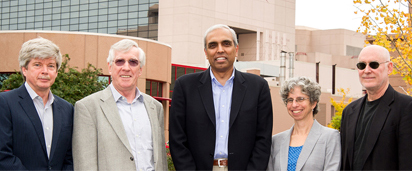TSRI and St. Jude Scientists Help Launch Human Dark Proteome Initiative
Scientists at The Scripps Research Institute (TSRI), St. Jude Children’s Research Hospital and other institutions have announced the launch of the Human Dark Proteome Initiative (HDPI). The initiative aims to accelerate research into biology’s “invisible mass” to provide novel insights into cell function and a new frontier in drug discovery.
The term “dark proteome” describes the large portion of the proteome—the complete collection of proteins in an organism—that do not adopt defined 3D structures. These little-studied proteins make up about one third of the human proteome and control many aspects of cellular behavior. Recent developments in technology, including advances in nuclear magnetic resonance (NMR) spectroscopy methods, now make it possible to look in detail at these “intrinsically disordered proteins” (IDPs) and the “intrinsically disordered regions” (IDRs) of these molecules.
“Our goal is to raise awareness about the potential societal impacts of a broad-based research infrastructure for these understudied proteins,” said Richard Kriwacki, a member of the St. Jude Department of Structural Biology and of the HDPI. “We also want to develop educational programs that will address the origins and potential cures of devastating diseases affected by these proteins that afflict large numbers of patients across the world.”
“IDPs are involved in heart disease, infectious disease, type 2 diabetes, cancer and many neurodegenerative diseases, such as Parkinson’s disease and Alzheimer’s disease,” said Peter Wright, who is Cecil H. and Ida M. Green Investigator at TSRI and chair of the HDPI. “We need to advance our understanding of the functions and molecular mechanisms of these proteins so we can work toward better therapies for these debilitating diseases.”

The Executive Committee of the Human Dark Proteome Initiative includes (left to right): Richard Kriwacki of St. Jude Children’s Research Hospital; Peter Wright of The Scripps Research Institute; Rohit V. Pappu of Washington University in St. Louis; Jean Baum of Rutgers University; and Jeffrey Hoch of UConn Health. Other members not shown are: Arthur G. Palmer III of Columbia University and Steven Finkbeiner of the University of California, San Francisco.
Wright and Kriwacki emphasized that dramatically expanded investment in basic and translational research into the dark proteome is needed to achieve the full potential for understanding and developing cures for many devastating diseases.
Many of the members of the new Human Dark Proteome Initiative were in Memphis last week for the Intrinsically Disordered Proteins session at the Southeastern/Southwestern Regional Meeting of the American Chemical Society.
Joining Kriwacki and Wright in spearheading the initiative are researchers from Columbia University (Arthur G. Palmer III), Rutgers University (Jean Baum), UConn Health (Jeffrey Hoch), University of California, San Francisco (Steven Finkbeiner) and Washington University in St. Louis (Rohit V. Pappu).
For more information, see the Human Dark Proteome Initiative website and the interview with Wright and Professor Jane Dyson in this week’s issue of News&Views.
Send comments to: press[at]scripps.edu













